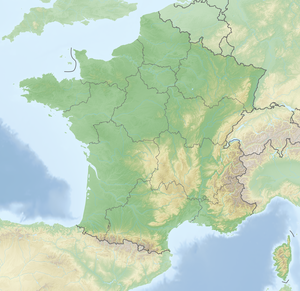Foix Castle
| Foix Castle | ||
|---|---|---|
|
Foix Castle |
||
| Alternative name (s): | Château de Foix | |
| Creation time : | approx. 10th century | |
| Castle type : | Höhenburg, rocky location | |
| Conservation status: | partially restored | |
| Standing position : | Count | |
| Place: | Foix | |
| Geographical location | 42 ° 57 '56 " N , 1 ° 36' 18" E | |
|
|
||
The Foix Castle (French: Château de Foix ) is the ruin of a medieval rock castle in the south of France , which rises above the town of Foix in the Ariège department . It was classified as a Monument historique by the French Ministry of Culture in 1840 and is therefore a listed building .
history
Remains of the earliest military uses of the rock of Foix (French: Roc de Foix ), which dominates the confluence of the Arget in the Ariège , are preserved from the 7th century. In 987 a castle on the rock is first mentioned in writing, which belonged to Count Roger the Elder of Carcassonne . He bequeathed it to his younger son Bernard Roger , who founded the Count's House of Foix and had the first tower of the castle, called Tour d'Arget , built. Count Roger II built the second tower, which is called Tour Pointue because of its tapered corner tower .
In the 12th century the castle became a center of the courtly world of Occitania . In the Canso de la Crosada , her ascribed strength was recognized by an anonymous trobador :
- "El castels es tant fortz qu'el mezeis se defent"
- (The castle is so strong, it defends itself)
Due to the support of the count's house for the heretical sect of the Cathars , Foix also became a target of the Albigensian crusade . The castle was successfully defended against the crusader Simon IV. De Montfort in 1211 and 1212 . After the defeat in the Battle of Muret in 1213, Count Raimund Roger voluntarily gave up the castle, but received it back the following year. In 1272 the castle was taken over by King Philip III. besieged by France to the Count Roger Bernard III. to subjugate. After two days of siege , the count surrendered to the overwhelming forces, but without the king being able to take the castle by force. Under the following counts, the castle lost its importance due to its inconvenience and was replaced as the main residence by the more representative castles in Orthez and Pau . For Count Gaston II it served as a dungeon for his mother. Count Gaston IV finally built the round tower ( Tour ronde ), which was given the function of a prison and gave the castle its current appearance. In 1486 the castle was conquered for the only time, by John of Foix-Étampes in a fight against his niece, Queen Catherine of Navarre .
After the last Count of Foix became King of France as Henry IV in 1589 , the castle was occupied by a royal garrison, which stayed there until the French Revolution . During this time, glittering parties were celebrated here, including by Jean-Armand du Peyrer , the Count of Tréville, who under King Louis XIII. Was captain of the Musketeers , and Philippe-Henri de Ségur , a minister of King Louis XVI. Until 1862 the castle was used as a prison.
Since 1930 the castle has housed the regional museum of the Ariège department, in which prehistoric, Gallo-Roman and medieval exhibits are on display.
The castle in art
The painting Berenguer III al castell de Foix shows Count Raimund Berengar III. of Barcelona in the battle for Foix Castle. The work is by the Catalan painter Marià Fortuny from 1857.
Web links
- Official website of the castle (French)
- A Brief History (English)
Individual evidence
- ↑ Martin-Chabot, Eugène (ed.): La chanson de la croisade albigeoise, Volume 2, in: Les classiques de l'histoire de France au moyen age, Volume 24, page 46, Paris 1957
- ↑ James McDonald: Château de Foix - Well Preserved Medieval Cathar Castle in France. Retrieved July 15, 2017 .


